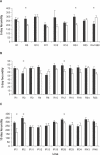From parasite to mutualist: rapid evolution of Wolbachia in natural populations of Drosophila
- PMID: 17439303
- PMCID: PMC1852586
- DOI: 10.1371/journal.pbio.0050114
From parasite to mutualist: rapid evolution of Wolbachia in natural populations of Drosophila
Abstract
Wolbachia are maternally inherited bacteria that commonly spread through host populations by causing cytoplasmic incompatibility, often expressed as reduced egg hatch when uninfected females mate with infected males. Infected females are frequently less fecund as a consequence of Wolbachia infection. However, theory predicts that because of maternal transmission, these "parasites" will tend to evolve towards a more mutualistic association with their hosts. Drosophila simulans in California provided the classic case of a Wolbachia infection spreading in nature. Cytoplasmic incompatibility allowed the infection to spread through individual populations within a few years and from southern to northern California (more than 700 km) within a decade, despite reducing the fecundity of infected females by 15%-20% under laboratory conditions. Here we show that the Wolbachia in California D. simulans have changed over the last 20 y so that infected females now exhibit an average 10% fecundity advantage over uninfected females in the laboratory. Our data suggest smaller but qualitatively similar changes in relative fecundity in nature and demonstrate that fecundity-increasing Wolbachia variants are currently polymorphic in natural populations.
Conflict of interest statement
Figures







References
-
- Herre EA, Knowlton N, Mueller UG, Rehner SA. The evolution of mutualisms: Exploring the paths between conflict and cooperation. Trends Ecol Evol. 1999;14:49–53. - PubMed
-
- Moran NA. Symbiosis. Current Biol. 2006;16:R866–R871. - PubMed
-
- Elena SF, Lenski RE. Evolution experiments with microorganisms: The dynamics and genetic bases of adaptation. Nat Rev Genet. 2003;4:457–469. - PubMed
-
- Hoffmann AA, Turelli M. Cytoplasmic incompatibility in insects. In: O'Neill S, Hoffmann AA, Werren JH, editors. Influential passengers: Inherited microorganisms and arthropod reproduction. Oxford: Oxford University Press; 1997. pp. 42–80.
-
- Hoffmann AA, Turelli M, Simmons GM. Unidirectional incompatibility between populations of Drosophila simulans . Evolution. 1986;40:692–701. - PubMed
Publication types
MeSH terms
Substances
Associated data
- Actions
- Actions
- Actions
- Actions
- Actions
- Actions
- Actions
- Actions
- Actions
- Actions
- Actions
- Actions
- Actions
- Actions
- Actions
- Actions
- Actions
- Actions
- Actions
- Actions
- Actions
- Actions
- Actions
- Actions
- Actions
- Actions
- Actions
- Actions
- Actions
- Actions
- Actions
- Actions
LinkOut - more resources
Full Text Sources
Other Literature Sources
Molecular Biology Databases

